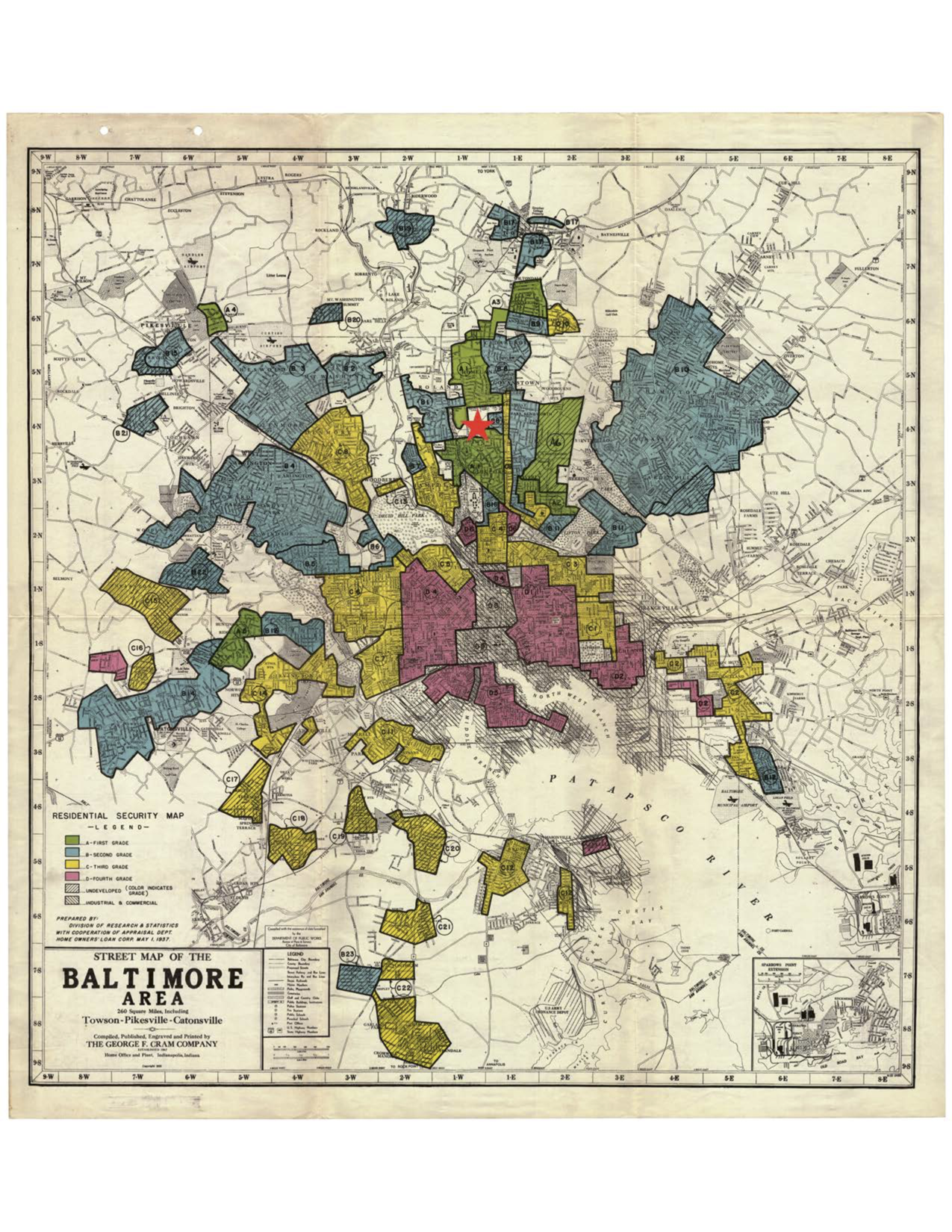
Disclaimer: I am not an expert on these subjects, by any means. Here are some materials I've collected that have helped me understand redlining and its effects, especially in Baltimore. I've also linked some brief explanations on subprime loans. I have introduced and discussed the issue in class. At the bottom of this page are some class materials I have used or created.
There are several ways housing developments, neighborhoods, and cities practiced discriminatory practices for housing. One is known as "redlining." This is called because neighborhoods were literally marked in red if they were deemed high financial risks. It became more difficult to get loans in those neighborhoods and the prices of homes suffered. Because of the values of the homes suffered, families that lived there had a difficult time moving away or accumulating wealth through their property. It has been studied that these neighborhoods still suffer, and the "green-lined" neighborhoods have thrived. Baltimore is often used as an example of the lasting effects of redlining. Baltimore is infamous for not only this practice but other discriminatory housing practices. See the links below for more history and explanation.
Another practice that is underfire for being discriminatory is subprime loans, which contributed to the Great Recession of 2008. As explained in some of the links below, subprime loans were given to "high risk" lenders and/or for buying in "high risk" locations. A basic example of a subprime loan is a high interest loan. A WeBWorK problem calculates the difference between a basic loan with a regular interest and high interest rate.
There is a video on redlining that explains what it is (was) and focuses on the housing developments on Long Island (some of you may be familiar with those locations). The video can be found through Loyola Notre Dame Library at http://lndl.kanopystreaming.com. You should be able to sign on with your Loyola credentials. Search for "Race: The Power of Illusion" (just "Power of Illusion" will work, too). The discussion on redlining is within Episode 3 starting at about 23:49. The part starts with a clip of a movie featuring a young Frank Sinatra. In the past, for class we watched until about 51:20 and stopped because of time (but the rest is good!).
Mapping Inequality: Redlining in New Deal America
1937 Baltimore Security Map: Loyola is marked with a star. There are three neighborhoods featured in a WeBWorK problem on compound interest. North Baltimore/Guilford/Homeland (Guilford) is within the green areas to the north and south of Baltimore. Greater Govans (Govans) is the neighborhood across (East) of York Road - the long vertical strip of yellow is a part of Govans. Sandtown-Winchester/Harlem Park (Sandtown) is within the redlined neighborhood D4 (just west of the cnter of the map).
(Click on image for larger, zoomable picture.)

Baltimore Neighborhood Indicator Alliance
How to Change the Racial Biases in Lending by Angelica Leicht on Interest.com
"Summer is hotter in Baltimore neighborhoods that have seen racial 'redlining.' And the difference is more extreme here" by Scott Dance. (The Baltimore Sun, January 15, 2020)
Redlining was banned 50 years ago. It's still hurting minorities today. (Washington Post, March 28, 2018)
Road to nowhere: how infrastructure built on American inequality (The Guardian, February 21, 2018)
1893 letter details racially restrictive covenants in city neighborhoods (Baltimore Sun, March 27, 2015)
Baltimore's Economy in Black and White
From Ferguson to Baltimore: The Fruits of Government-Sponsored Segregation (Economic Policy Institute, Working Economics Blog April 29, 2015)
Johns Hopkins Magazine story on Roland Park
Baltimore Sun article on Mapping Inequalities
City Paper article on Mapping Baltimore
Stoop Stories: These are my two Baltimores by D Watkins
Two Baltimores: The White L vs. the Black Butterfly
Investipedia explaining subprime loans
NPR 2007 story on subprime loans
Interest-Only Mortgage Tutorial
Blog post of the unit with updated class materials, including links to the talks I presented in January 2020 at the JMM and co-presented with Mike Puma in February 2020 at FYE 2020.
Lisa Oberbroeckling